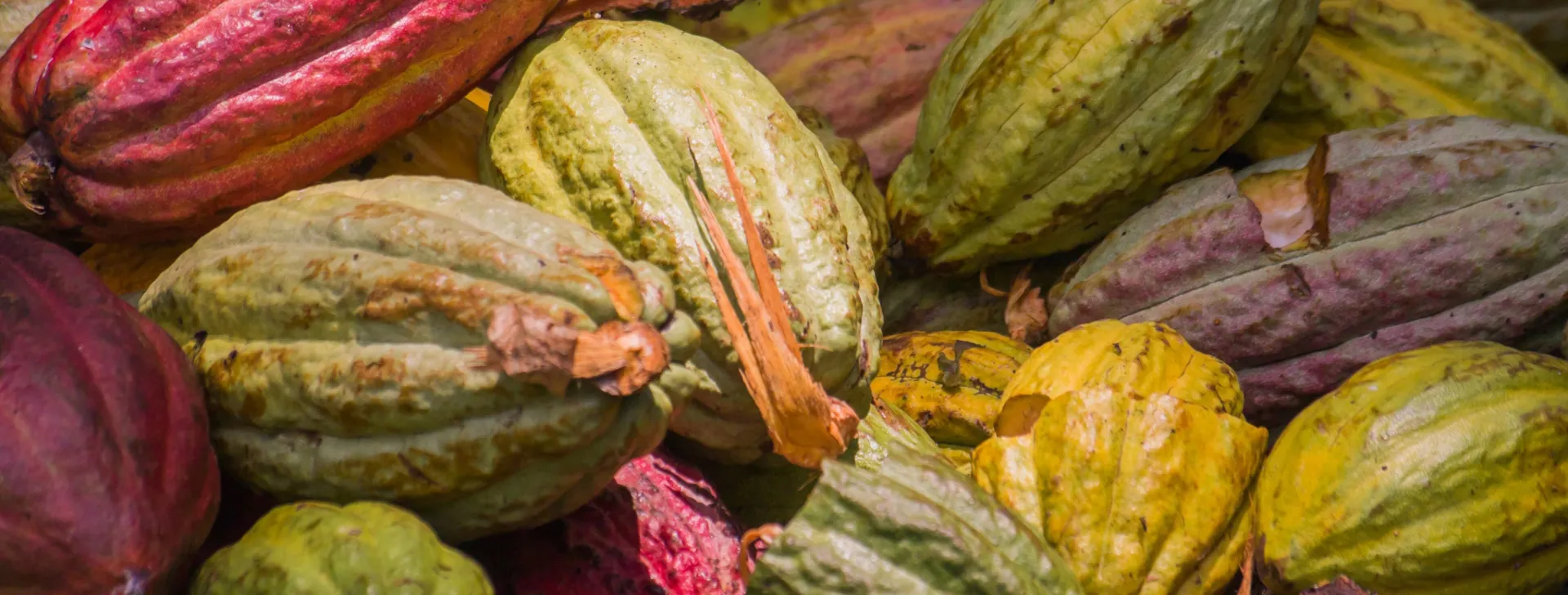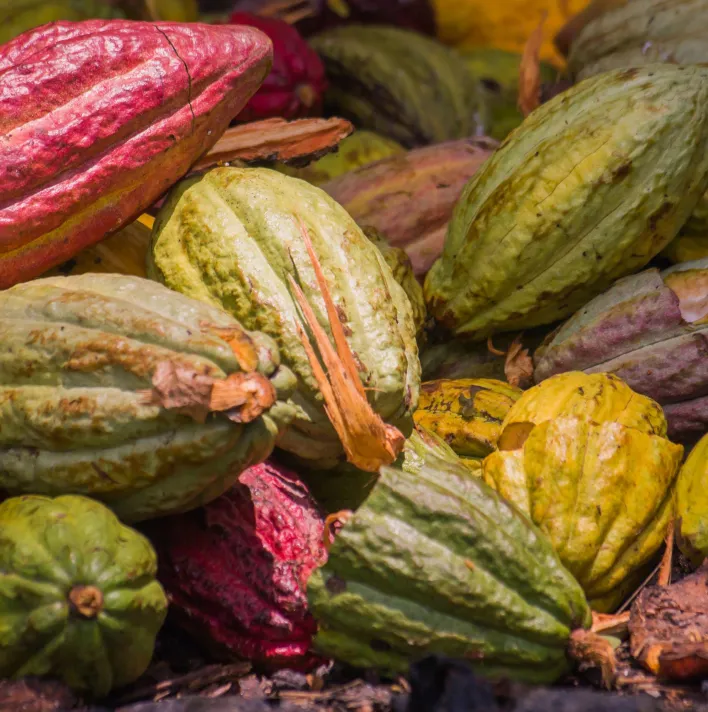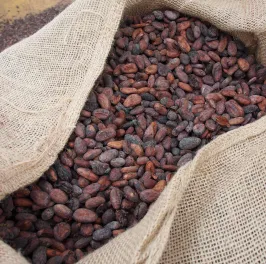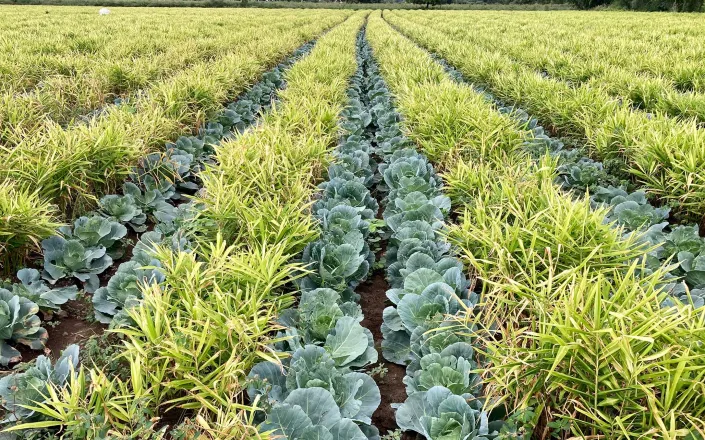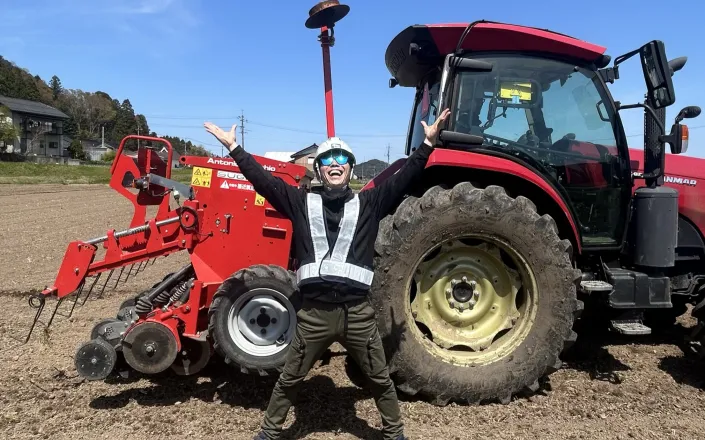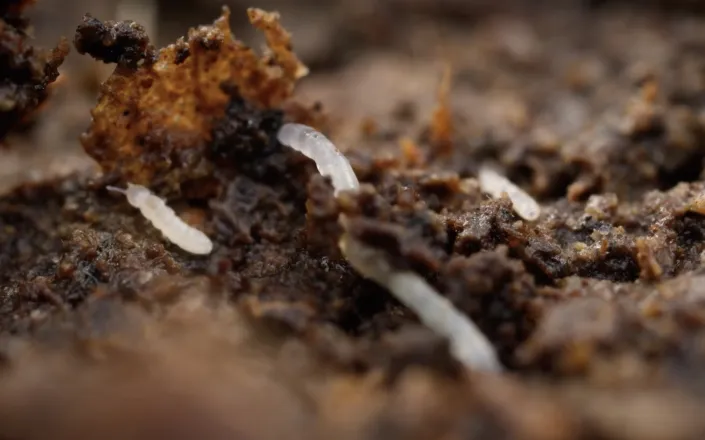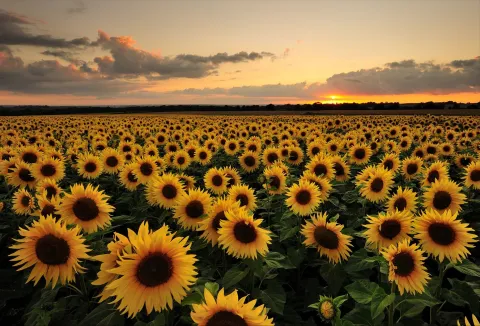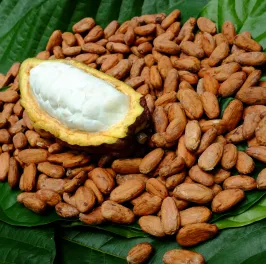
The future of chocolate is at a crossroads. Cocoa farming faces unprecedented challenges from climate change, rising diseases, and volatile cocoa prices. Agricultural innovation and support for farmers can make a difference.
Cocoa vs. Cacao:
What's the difference?
Cocoa and cacao come from the same beans of the Theobroma cacao tree. They're just different stages of processing. Cacao is the first step – raw or lightly processed beans. Cocoa is the second step – beans that have also been roasted.
What are the 4 main varieties of cocoa bean? Forastero Criollo Trinitario Nacional
Cocoa trees and their beans are usually grouped into three types: Forastero, Criollo, and Trinitario.
- Forastero makes up 80-90% of all bean production. It’s hardy, high yielding and resistant to disease. Taste is robust and earthy. It mainly grows in West Africa.
- Criollo is rare and prized for its delicate and complex aromatic flavor. It accounts for 1-5% of the supply and is favored by craft chocolate makers.
- Trinitario is a hybrid combining Forastero and Criollo. Trinitario produces less than 10% of the world's cocoa.
- Some classifications also mention Nacional, another rare, high-quality type known for its fine, floral flavor.
How long does cocoa take to grow?
Trees take around 4-5 years to bear fruit but are productive for 25-30 years. Research is under way to produce faster-yielding varieties. Once pollinated, pods take about 6 months to reach maturity, allowing growers to plan their harvesting time.
How are cocoa beans harvested and how often?
Harvesting is labor-intensive as the ripe pods have to be cut from the trees by hand. There can be two harvests – one main and one light crop, depending on climate. In peak season, farmers need to monitor the trees for newly ripe pods and harvest frequently.
Why are cocoa prices rising?
Rising prices are due to a global cocoa shortage caused by weather, disease and pest damage to harvests, low farmer profitability, and long-term under-investment in farms, resulting in poor soil and ageing trees.
Prices reached historical highs of nearly $10,000 per metric tonne in 2024, and forecasts are for inflation to continue.
Around 60% of cocoa is produced in West Africa, which has been particularly badly hit by extreme weather and rising disease.
Alongside that, retailers and consumers have cut their spending due to rising living costs caused by geopolitical volatility.
Is there a cocoa shortage?
Demand has outstripped supply since 2021. The global cocoa shortage reached a record deficit -478,000 metric tonnes in the 2023-2024 season, according to the International Cocoa Organization (ICCO).
Forecasters expect the shortage to ease to around -100,000 metric tonnes in the 2024-2025 season. Analysts anticipate production will increase, thanks to lower pressure from disease and improved weather in West Africa.
Forecasters expect production to increase, but not by enough to alleviate the cocoa shortage entirely.
How big is the cocoa shortage?
216,000 metric tonnes
99,000 metric tonnes
478,000 metric tonnes
100,000 metric tonnes forecast
How profitable is cocoa farming?
Cocoa farming is the main source of income for millions of smallholders, particularly in West Africa.
Many smallholders’ incomes are less than the poverty line of $2 per day. Farmers generally receive a very small percentage (3-6%) of the final retail price of chocolate.
They often do not have the financial resources to invest in their farms. Families tend to be large, children can end up working in the fields, and women often receive lower pay than men.
Fair trade programs can raise the prices paid to farmers, and support to help them access modern agricultural tools along with training can increase their productivity, yields and incomes.
Innovation Brings New Options for Farmers
Cocoa farmers in West Africa are improving their livelihoods with the use of Syngenta’s innovative products PERGADO® Ultra and PERGADO® Cocoa, designed specifically for the weather and environment of the region.
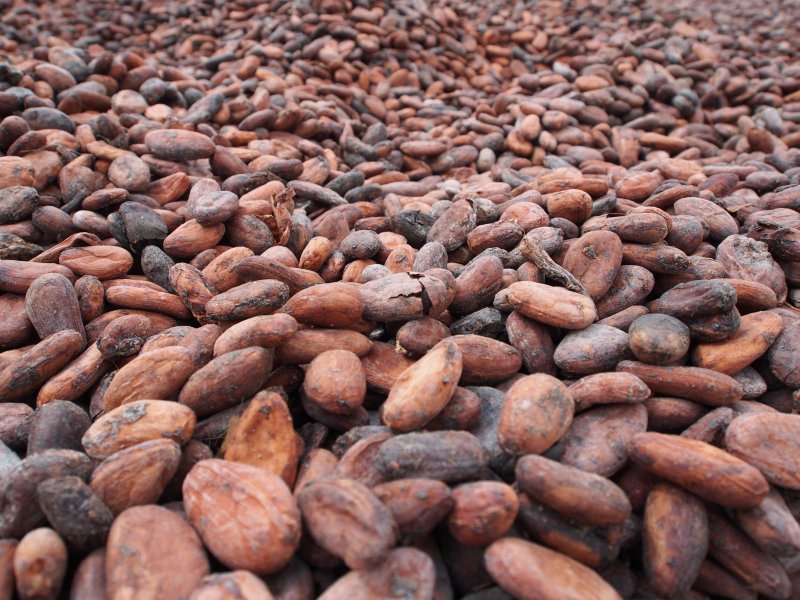
Which country produces the most cocoa?
West Africa produces around 60% of global supply – Côte d’Ivoire produces around 40% and Ghana 20%. Nigeria and Cameroon also contribute smaller volumes.
In Southeast Asia, Indonesia produces around 10-12%. Latin America is a significant bean-producing region with Ecuador, the Dominican Republic, Peru, Colombia, and Brazil contributing.
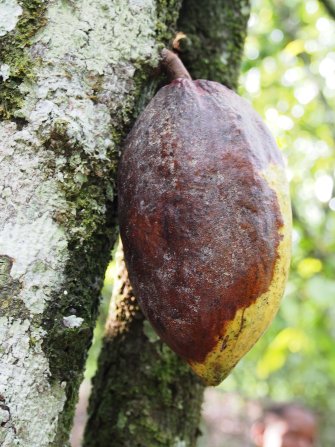
How sustainable is cocoa farming?
Cocoa farming faces many challenges – environmental, economic, agricultural and social. Businesses, governments and non-profit groups are helping local communities to change, but there is a long way to go.
Environment
Sustainable harvests are threatened by climate change, which has increased bad weather. More pests and diseases like Cocoa Swollen Shoot Virus Disease (CSSVD), cocoa mirids, and black pod disease are piling on the pressure and significantly impacting the yields
Deforestation is a major concern, especially in West Africa, where forests are cleared to plant new trees. This leads to habitat loss and reduced biodiversity.
Economic
Many smallholders and their families lack financial stability, often earning less than $2 a day. Farmers often cannot afford to invest in order to adequately improve their production, and much education and training are required.
Agricultural
Growing conditions are often unsustainable. Soil is of poor quality and trees are ageing and unproductive. Smallholders often lack modern agricultural tools.
Social
Family life is under pressure. Many smallholders can’t afford basic needs or to invest. They often receive a very small percentage (3-6%) of the final chocolate price.
Child labor can be an issue, younger generations often lack interest in continuing the farm, and women find it difficult to access resources and training.
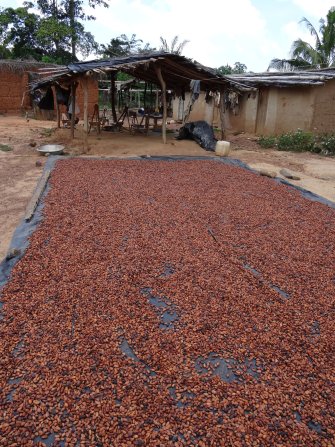
How can cocoa farming become more sustainable?
Support for local communities is key for sustainability. Many companies and non-profits help farmers adopt new, more productive, and more sustainable ways of working, but more efforts are needed.
Agricultural innovation
Better farming tools and practices can improve production and help the environment. New sustainable crop protection products can help to combat bad weather and disease outbreaks.
Training in modern methods of cultivation and care for the soil can increase productivity, reducing the need to cut down forests.
Farmer livelihoods
In Ghana, Syngenta works with Cocobod (CHED) to train farmers and raise productivity, yield and incomes. Farmers get advice on practices like pruning, hand pollination, and protecting pods with innovative solutions, as well as when to implement good agricultural practices. They are also supported with basic tools to support their farming activities.
In Cameroon, Syngenta is running two pilot projects. One helps women farmers diversify earnings and become more financially stable. The second uses weather and tracking data to make sure crop protection products are used in the optimal way.
Improving Cocoa Farmers’ Livelihoods
In Ghana, Syngenta works with Cocobod to train farmers and raise productivity, yield and incomes. Farmers get advice on practices like pruning, pollination, and protecting pods, as well as when to plant and the best conditions. They also get the newest products to protect their crops.
What are the main challenges for cocoa farmers?
There are many difficult problems, from extreme weather to a lack of tools and training, and tough social conditions.
Climate change has brought damaging weather including torrential rain, rising temperatures and drought. Serious outbreaks of pests and disease are piling on the pressure.
Soil on cocoa farms is often of poor quality and trees are ageing and unproductive. Smallholders often lack the resources to invest and the products and training that support good agricultural practices.
Many smallholders and their families live in poverty, often earning less than $2 a day. Child labor and lower incomes for women are also issues.
What are the benefits of cocoa farming?

Cocoa is the main source of income for millions of smallholder farmers, especially in West Africa. The global chocolate industry, valued at over USD 100 billion annually, is a significant potential opportunity for farmers – if they receive adequate support to make their farms more sustainable.
Farmers’ livelihoods can be improved through innovative agricultural products and training in good agricultural practices leading to higher productivity, yield and incomes.
Fair trade programs guarantee smallholders a minimum price and support investment in farms or community projects like schools, healthcare facilities, and infrastructure.
Training and access to resources can improve the lives of women in farming communities, and stakeholders can continue working to end child labor on farms.
While cocoa production currently has many challenges, different approaches from stakeholders in partnership show that chocolate can have a sustainable future.
Know more about sustainable farming
